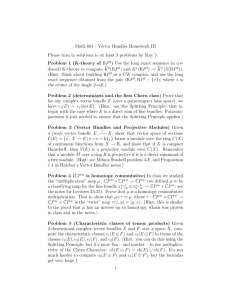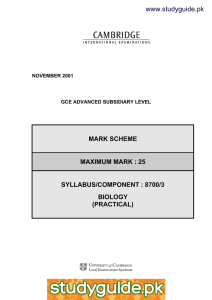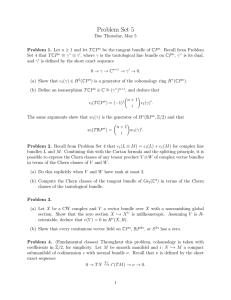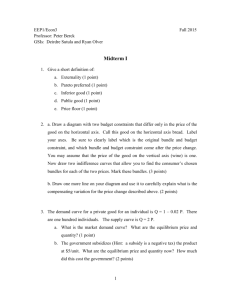DOUBLE COVERS AND VECTOR BUNDLES Vasile Brˆınz˘ anescu
advertisement
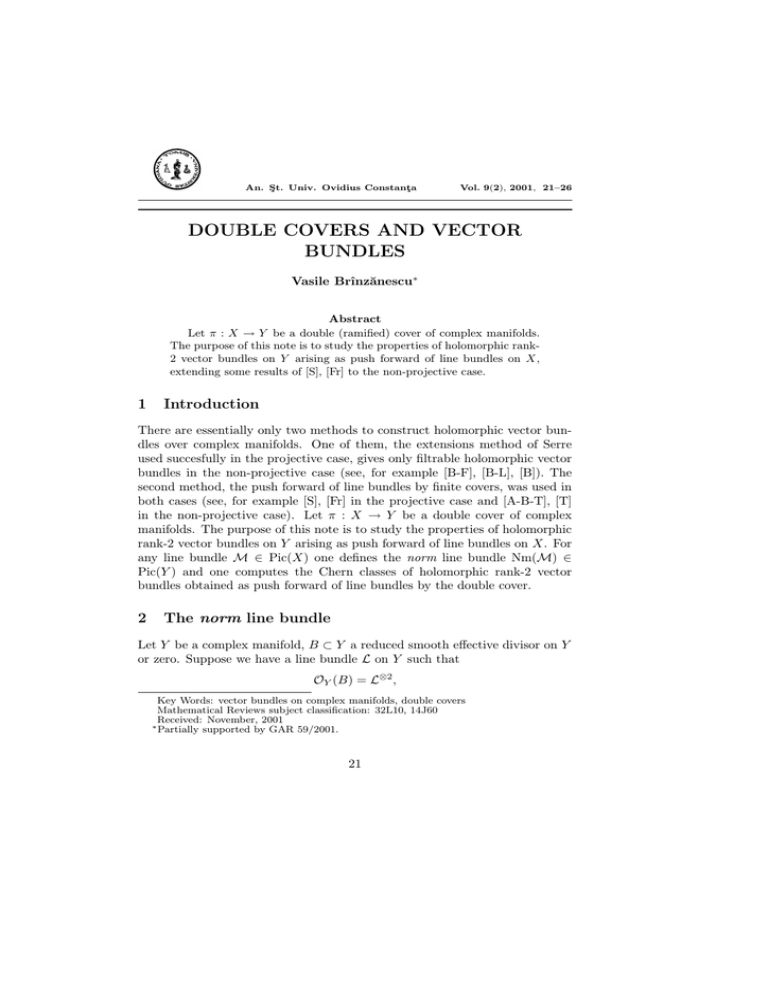
An. Şt. Univ. Ovidius Constanţa
Vol. 9(2), 2001, 21–26
DOUBLE COVERS AND VECTOR
BUNDLES
Vasile Brı̂nzănescu∗
Abstract
Let π : X → Y be a double (ramified) cover of complex manifolds.
The purpose of this note is to study the properties of holomorphic rank2 vector bundles on Y arising as push forward of line bundles on X,
extending some results of [S], [Fr] to the non-projective case.
1
Introduction
There are essentially only two methods to construct holomorphic vector bundles over complex manifolds. One of them, the extensions method of Serre
used succesfully in the projective case, gives only filtrable holomorphic vector
bundles in the non-projective case (see, for example [B-F], [B-L], [B]). The
second method, the push forward of line bundles by finite covers, was used in
both cases (see, for example [S], [Fr] in the projective case and [A-B-T], [T]
in the non-projective case). Let π : X → Y be a double cover of complex
manifolds. The purpose of this note is to study the properties of holomorphic
rank-2 vector bundles on Y arising as push forward of line bundles on X. For
any line bundle M ∈ Pic(X) one defines the norm line bundle Nm(M) ∈
Pic(Y ) and one computes the Chern classes of holomorphic rank-2 vector
bundles obtained as push forward of line bundles by the double cover.
2
The norm line bundle
Let Y be a complex manifold, B ⊂ Y a reduced smooth effective divisor on Y
or zero. Suppose we have a line bundle L on Y such that
OY (B) = L⊗2 ,
Key Words: vector bundles on complex manifolds, double covers
Mathematical Reviews subject classification: 32L10, 14J60
Received: November, 2001
∗ Partially supported by GAR 59/2001.
21
22
V. Brı̂nzănescu
and a section s ∈ Γ(Y, OY (B)) vanishing exactly along B (if B = 0 we take
for s the constant function 1). We denote by L the total space of L and we
let p : L → Y be the bundle projection. If t ∈ Γ(L, p∗ L) is the tautological
section, then the zero divisor of p∗ s − t2 defines an analytic subspace X in L.
If B 6= 0, since B is reduced and smooth, then also X is smooth and π = p| X
exhibits X as a 2-fold ramified covering of Y with branch-locus B. We call
π : X → Y the 2-cyclic covering (or ramified double cover) of Y branched
along B, determined by L. If B = 0, we take L 6∼
= OY ; in this case π : X → Y
is called the 2-cyclic unramified covering (or unramified double cover) of Y
determined by L.
Conversely, given π : X → Y a finite morphism of degree two between
complex manifolds, we can recover B and L as follows. Let τ : X → X be the
sheet interchange involution, i.e. τ 2 = id, π ◦ τ = τ . Then B is the image
under π of the fixed set of τ and π∗ OX = OY ⊕ L−1 , where the direct sum
decomposition corresponds to taking the +1 and −1 eigenspaces of τ acting
on π∗ OX (see, for example [B-P-V], [M], [Fr]).
The morphism π : X → Y induces the natural homomorphism
π ∗ : Pic(Y ) → Pic(X).
In the projective case, by using the natural map π∗ : Div(X) → Div(Y )
between the group of divisors on X and similarly on Y , one obtains a homomorphism
π∗ : Pic(X) → Pic(Y ).
In the non-projective case, since the group of divisors could be very small, we
have to find some other substitute for the map π∗ by using line bundles.
Let G = {id, τ } be the group of the double cover π : X → Y . Let M ∈
Pic(X) be a line bundle. Since
τ ∗ (M ⊗ τ ∗ M) ∼
= M ⊗ τ ∗ M,
then
M ⊗ τ ∗ M ∈ Pic(X)G .
It follows that π∗ (M ⊗ τ ∗ M) is a G-sheaf and, as a rank 2-vector bundle on
Y , splits as a direct sum of line bundles corresponding to taking +1 and −1
eigenspaces of τ . Thus, we have
π∗ (M ⊗ τ ∗ M) ∼
= (π∗ (M ⊗ τ ∗ M))G ⊕ Z,
where the first factor is the invariant part of the G-sheaf π∗ (M ⊗ τ ∗ M).
We have
23
Double covers and vector bundles
Definition 1 Let M ∈ Pic(X) be a line bundle. The line bundle
NmM := (π∗ (M ⊗ τ ∗ M))G
is called the norm line bundle of M.
Lemma 2 π ∗ (NmM) ∼
= M ⊗ τ ∗ M.
Proof: There exists a natural morphism of line bundles
π ∗ (π∗ (M ⊗ τ ∗ M)G ) → M ⊗ τ ∗ M.
For any x ∈ X let y = π(x) ∈ Y and choose a Stein neighbourhood V of
y; then π −1 (V ) is a Stein neighbourhood of π −1 (y) and one finds a section
s ∈ M(π −1 (V )) with s(xi ) 6= 0 for all xi ∈ π −1 (y). Then s.sτ is a G-invariant
section of M ⊗ τ ∗ M(π −1 (V )), which generates M ⊗ τ ∗ M in a neigbourhood
of π −1 (y). It follows that the above natural morphism is an isomorphism.
3
Rank-2 vector bundles
Let π : X → Y be a double cover as above. We have that π∗ OX ∼
= OY ⊕ L−1
is an OY - algebra, which is coherent as an OY -module. Multiplication is given
by
(a, l).(b, m) = (ab + Φ(l ⊗ m), am + bl),
where a, b are (local) sections of OY , l, m are (local) sections of L−1 , for
some isomorphism
∼
Φ : L−2 → OY (−B) ⊂ OY .
In fact, X = Specan(A), where A = π∗ OX is a sheaf of OY -algebras and for
any OX -module F the OY -module π∗ F is an A-module (see [Fi]).
Let M ∈ Pic(X) be a line bundle. For the rank-2 vector bundle π∗ M we
have the following result:
Theorem 3 det(π∗ M) ∼
= NmM ⊗ L−1 .
Proof: Since π : X → Y is a finite morphism we have the isomorphism:
∼
∗
) → H 1 (Y, (π∗ OX )∗ ).
H 1 (X, OX
(1)
(see [H], [M]). By choosing a suitable open covering U = (Ui ) of Y we can
suppose that all the vector bundles L, π∗ OX and π∗ M have local trivializations with respect to this open covering. If (fij ) is an 1-cocycle of the covering
U with coefficients in OY∗ , which defines the line bundle L, then the rank-2
24
V. Brı̂nzănescu
vector bundle A = π∗ OX ∼
= OY ⊕ L−1 is defined with respect to this covering
by the 1-cocycle
1
0
−1
0 fij
In fact, we have the local trivializations
ϕi
OUi → L−1 |Ui
and the isomorphisms composition
ϕ−1
ϕj
i
OUi ∩Uj → L−1 |Ui ∩Uj →
OUi ∩Uj ,
−1
such that fij
= (ϕ−1
i ◦ ϕj )(1). Then, we get the isomorphisms composition
2
2
OU
→ A|Ui ∩Uj → OU
,
i ∩Uj
i ∩Uj
given by the above matrix.
The morphism Φ : L−2 → OY gives the morphisms
⊗2
Φij : OU
→ L−2 |Ui ∩Uj → OUi ∩Uj ,
i ∩Uj
where Φij (l ⊗ m) = lmtij , tij ∈ O(Ui ∩ Uj ).
∗
) defines by the isomorphism
The line bundle M ∈ Pic(X) ∼
= H 1 (X, OX
∗
(1) an 1-cocycle (γ̃ij ), γ̃ij ∈ A (Ui ∩ Uj ). Let γij be the composition
1⊕ϕj
γ̃ij
O2 (Ui ∩ Uj ) → A(Ui ∩ Uj ) → A(Ui ∩ Uj )
1⊕ϕ−1
i
→
O2 (Ui ∩ Uj );
then (γij ) is an 1-cocycle which defines the rank-2 vector bundle π∗ M. If we
write γij = (c0ij , c00ij ), for any (α, β) ∈ O 2 (Ui ∩ Uj ), we get
−1 0
γij (α, β) = (c0ij α + c00ij tij β, fij
(cij β + c00ij α)).
It follows that an 1-cocycle which defines the rank-2 vector bundle π∗ M is
given by the following matrix
c0ij
c00ij tij
−1 00
fij
cij
c0ij
Then, the line bundle det(π∗ M) is given by the 1-cocycle
−1
fij
((c0ij )2 − tij (c00ij )2 ).
25
Double covers and vector bundles
In the direct sum decomposition π∗ OX = OY ⊕ L−1 , the second factor
corresponds to the −1 eigenvalue of τ . It follows that an 1-cocycle defined by
the line bundle M ⊗ τ ∗ M in H 1 (Y, (π∗ OX )∗ ) is given by
γij .τ ∗ γij = (c0ij , c00ij ).(c0ij , −c00ij ) = ((c0ij )2 − tij (c00ij )2 , 0).
For the rank-2 vector bundle π∗ (M ⊗ τ ∗ M) we get the 1-cocycle given by the
following matrix
(c0ij )2 − tij (c00ij )2
0
0
−1
0 2
fij ((cij ) − tij (c00ij )2 )
It follows that the G-invariant part of π∗ (M ⊗ τ ∗ M), i.e. NmM is given
by an 1-cocycle (c0ij )2 − tij (c00ij )2 . Finally, we get
det(π∗ M) ∼
= NmM ⊗ L−1 .
Lemma 4 We have the exact sequence of vector bundles on X:
0 → τ ∗ M ⊗ π ∗ (L−1 ) → π ∗ (π∗ M) → M → 0.
Proof: (see [Fr]) The natural morphism
π ∗ (π∗ M) → M
is surjective; then the kernel is the line bundle
det(π ∗ (π∗ M)) ⊗ M−1 = π ∗ (det(π∗ M)) ⊗ M−1 .
By applying Theorem 3 and Lemma 2 we get the desired result.
Corollary 5
c2 (π∗ M) =
1 2
(c (NmM) − π∗ (c21 (M)) − π∗ (c1 (M)).c1 (L)).
2 1
Proof: (see [Fr]) By applying all the results above and the projection formula
one gets the conclusion.
Remark By using push forward of line bundles by finite covers in [A-B-T] one
obtained the complete answer to the existence problem of holomorphic vector
bundles of any rank over primary Kodaira surfaces.
26
V. Brı̂nzănescu
References
[A-B-T]
Aprodu,M., Brı̂nzǎnescu,V., Toma,M., Holomorphic vector bundles on primary
Kodaira surfaces, Math.Z. (2001), (DOI) 10.1007/s002090100307
[B-L]
Bănică, C., Le Potier, J., Sur l’existence des fibrés vectoriels holomorphes sur les
surfaces non-algébriques, J. Reine Angew. Math. 378, (1987), 1-31
[B-P-V]
Barth, W., Peters, C., Van de Ven, A., Compact Complex Surfaces, SpringerVerlag, 1984
[B]
Brı̂nzǎnescu, V., Holomorphic Vector Bundles over Compact Complex Surfaces,
Lect. Notes Math., 1624, Springer-Verlag, 1996
[B-F]
Brı̂nzǎnescu, V., Flondor, P., Holomorphic 2-vector bundles on non-algebraic
2-tori, J. Reine Angew. Math. 363, (1985) 47-58
[Fi]
Fischer, G., Complex Analytic Geometry, Lect. Notes Math., 538, Springer-Verlag
1984
[Fr]
Friedman, R., Algebraic Surfaces and Holomorphic Vector Bundles, SpringerVerlag, 1998
[H]
Hartshorne, R., Algebraic Geometry, Graduate Texts in Math., 49, SpringerVerlag, 1977
[M]
Mumford, D., Prym Varieties I, Contribution to Analysis, Acad. Press, New
York, (1974) 325-350
[S]
Schwarzenberger, R. L. E., Vector bundles on the projective plane, Proc. London
Math. Soc. 11, (1961) 623-640
[T]
Toma, M., Une classe de fibrés vectoriels holomorphes sur les 2-tores complexes,
C.R. Acad. Sci. Paris, 311, (1990) 257-258
Institute of Mathematics
of the Romanian Academy,
P. O. Box 1-764,
RO-70109 Bucharest,
Romania
e-mail: Vasile.Brinzanescu@imar.ro
